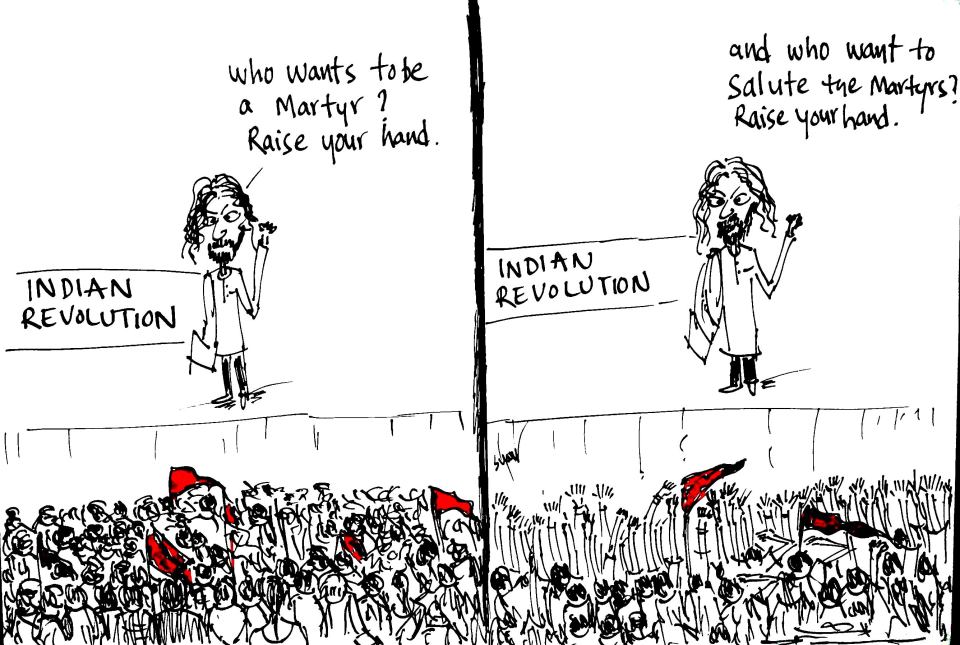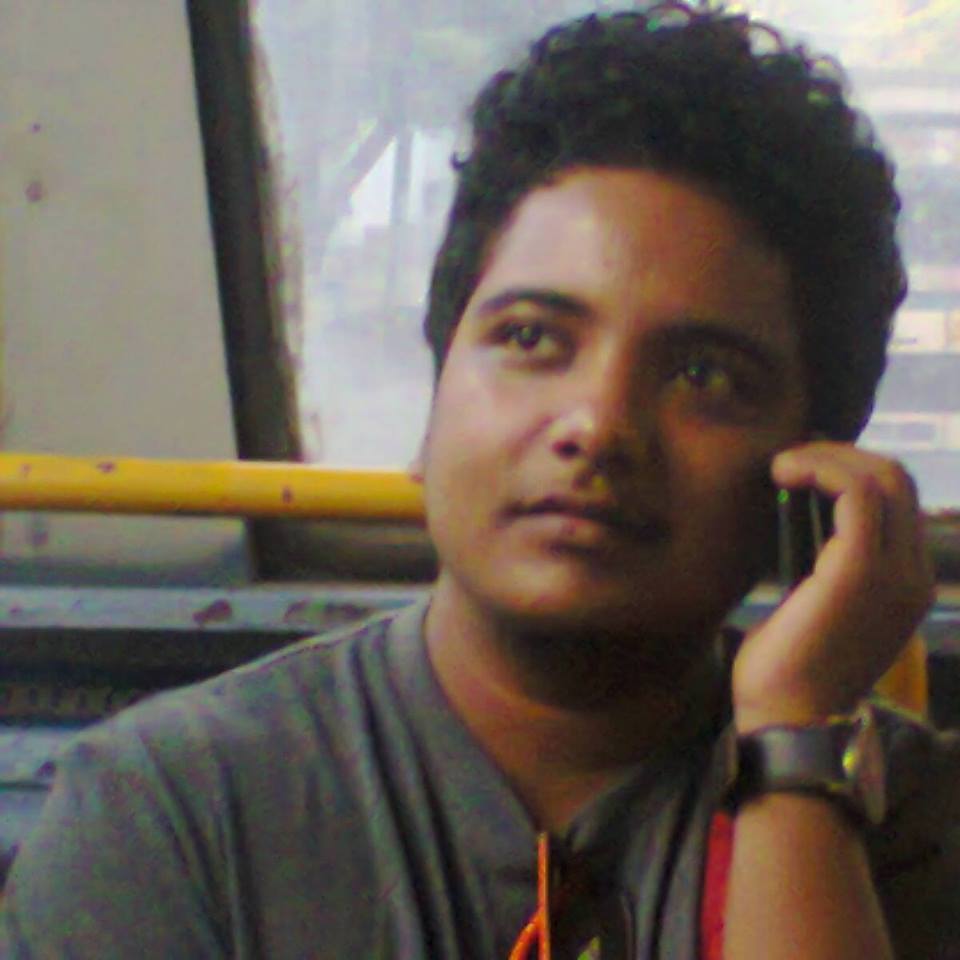Kuffir
Unfortunately thought in India is rare, and free thought is rarer still. This is particularly true of Hindus.
~ Babasaheb Ambedkar, in the epilogue to ‘Pakistan, or The Partition of India’.
The left has been questioning the foundations of anti-caste politics recently, a little more whiningly than it usually does because it has been suffering a lot. The dalitbahujans have been leaving the left movement, represented by its various avatars, in droves. But its brahminized leadership, instead of doing some much needed introspection, has launched a malicious campaign against the politically conscious dalitbahujans. It’s obvious that the dalitbahujans have developed serious misgivings about how the left understands the concrete reality of India, and how it doesn’t understand caste. The understanding, especially, of those who can only be called ‘groupies’ of the left movement (members of civil society and others, unaffiliated with any formal left organization), as this article tries to discuss, has been more shallow and prejudice-driven, even as their voices become shriller, and more visible, in the entirely savarna run ‘mainstream’ and ‘alternative’ media. Is the left in India capable of free thought?
~
Ambedkar realised that in a society where the Hindu scriptures institutionalise untouchability and inequality, the battle for “untouchables”, for social and civic rights, was too urgent to wait for the promised Communist revolution. The rift between the Ambedkarites and the Left has come at a great cost to both. It has meant that a great majority of the Dalit population, the backbone of the Indian working class, has pinned its hopes for deliverance and dignity to constitutionalism, to capitalism and to political parties like the BSP, which practise an important, but in the long run, stagnant brand of identity politics.
~ Arundhati Roy in ‘Capitalism: A Ghost Story‘.
She doesn’t talk about what the majority of the left did to sustain the rift, it seems only the Dalits carried that burden, with their ‘constitutionalism’ ‘capitalism’ and ‘stagnant brand of identity politics’. The left stuck to statism, casteism and vanguardism, perhaps? No? You would think one can clap with one hand.
And the Left, you’ll notice, is caste-less but the Dalits are full of stagnant ‘identity politics’. And Arundhati Roy is also above class interests or caste biases, of course. Unlike these young Dalit scholars:
Young Dalit scholars who accept grants from the Ford Foundation cannot be too harshly judged. Who else is offering them an opportunity to climb out of the cesspit of the Indian caste system?
The young Dalit scholars are looking for an ‘opportunity to climb out of the cesspit of the Indian caste system’: meaning they’re pursuing personal interests solely, not trying to work on any social upliftment. Unlike Roy who writes for corporate media for social upliftment, not to meet any personal needs.
She makes it seem like the Dalits somehow dug the cesspit on their own, for some unfathomable reason, and pushed themselves into it. No one else had any role in digging it and dumping the Dalits there. Where is the acknowledgment that Roy herself is part of the caste system?

~
The article is about capitalism and it seems to imply: Roy lives in the capitalist order while the Dalits live in the caste system, or suffer from the collective delusion that they live in the caste system, and they are two different worlds that are unconnected with each other.
Roy, of course, suffers from no delusions and has a perfectly healthy mind. If you don’t notice any casteism in her words it’s probably because you also have a perfectly healthy mind.
The truth is: Dalits read what Roy produces and Roy consumes what Dalits produce. They’re connected, and their relationship isn’t a ghost story.
So that’s what Dr. Ambedkar was trying to say: stop talking about ghosts and spirits and other mumbo jumbo and acknowledge this relationship. Talk about ways of dealing with the pain and hurt and exploitation that is the only benefit the Dalits get out of this relationship.
He didn’t sulk with the Left and chuck their friendship because of the implied, again, personal reasons. He left the Indian left alone because he sensed it had no social consciousness, or only a very underdeveloped one. Just like Roy, the Left had refused to acknowledge the relationship between the Dalits and themselves.
The further back we trace the course of history, the more does the individual, and accordingly also the producing individual, appear to be dependent and to belong to a larger whole.
There is no question of Roy and the Dalits living in different worlds, they belong to a ‘larger whole’: one society, one political economy. Whether she refuses ‘to force-fit the idea of caste into Marxist class analysis’, unlike the communist movement, or not, they continue ‘to be dependent’ parts of a larger whole.
~
By refusing to force-fit caste into class analysis, she seems to want to relegate it to the world of ideas, or culture. Others have tried to fit it into the economic base, yet others have tried to grudgingly grant it a role in regulating the distribution of social product, not production, the ‘decisive phase’, as Marx puts it.
Distribution, or their share in social product, is what placed the young Dalit scholars in the cesspit, and Roy outside it. Distribution is what ensured Roy better access to better food, shelter, education and career opportunities all through her life while it kept pushing the Dalit scholars back into the cesspit of want each time they tried to get out of it. Caste does regulate distribution.
~
But does caste determine distribution?
Marx also points out that distribution and production are also not unconnected.
Distribution according to the most superficial interpretation is distribution of products; it is thus removed further from production and made quasi-independent of it. But before distribution becomes distribution of products, it is (1) distribution of the means of production, and (2) (which is another aspect of the same situation) distribution of the members of society among the various types of production (the subsuming of the individuals under definite relations of production).
And he goes on to say:
It is evident that the distribution of products is merely a result of this distribution, which is comprised in the production process and determines the structure of production. To examine production divorced from this distribution which is a constituent part of it, is obviously idle abstraction; whereas conversely the distribution of products is automatically determined by that distribution which is initially a factor of production.
So what determines the distribution of products after production is ‘the distribution of means of production and the distribution of the members of society among the various types of production‘ before it.
Therefore, production is the decisive phase, so how can one say that because distribution in the capitalist order in India seems to follow a caste like social allocation pattern that caste also determines production? It is class identity that determines the distribution of social product and not caste identity.
~
But is class identity much more important than caste identity in India? Are they two unconnected identities? Is Roy, even if her carbon footprint is, say, some 70 times bigger than theirs, as much a helpless victim as the Dalit scholars, as she claims?
But which of us sinners was going to cast the first stone? Not me, who lives off royalties from corporate publishing houses. We all watch Tata Sky, we surf the net with Tata Photon, we ride in Tata taxis, we stay in Tata Hotels, we sip our Tata tea in Tata bone china and stir it with teaspoons made of Tata Steel. We buy Tata books in Tata bookshops. Hum Tata ka namak khate hain. We’re under siege.
And that is how Roy dismisses all the Dalit scholars’ grievances about how their Dalitness plays a role in marginalizing them.
For her, it’s obvious class identity is concrete reality while caste identity is a malingerer’s excuse, at best. By recognizing the real, concrete enemy while still enjoying ‘royalties’ coming from that source Roy is being less venal than the Dalit scholars who crave for pittances from the same enemy. Stand up and applaud Roy for not stooping to the level of the Dalit scholars, as Sitaram Yechury would say.
By ‘not stooping’ to the level of the Dalit scholars, Roy has glossed over all the inequalities in opportunities and erased the difference in outcomes between her and them, or broadly hinted that such differences are unimportant.
Roy would like to project the idea that she and the Dalit scholars started out from the same social position, and it’s somehow a mere accident that she is ahead of them in income, status, all round security and well-being, that she gets more of the social product.
But the fact remains that Roy and the Dalit scholars did not start out from the same position. Her kin started out from a similar position as her, her parents started out from similar positions as her, and we will find out that so did her grandparents and so on, if we dig a little deeper. While the Dalit scholars’ kin, parents and grandparents started out from similar positions as them.
It is not an accident that she is where she is, that her social position is being reproduced through generations. Her class identity mostly serves as a mask for her caste identity.
The Tatas have laid siege to her home because they would probably like to know when she wants to be served.
~
Tata Sky, Tata Photon, Tata taxis, Tata Hotels, Tata tea.
She could have mentioned Tata or Tanishq diamond nose studs as well. The Dalit scholars might get to eat Tata’s namak, but they don’t get to wear Tata diamonds, we can be sure. Bata chappals, maybe, but not Tata diamonds. Tata diamonds are more valuable than Bata chappals, meaning more labour goes into their production. What the Roys consume usually makes more demands on production than what the Dalit scholars consume.
That’s what the NSSO surveys periodically affirm: that there’s a caste pattern in consumption. That there’s a hierarchy of consumption in Indian society that closely follows the old varna order, with some variations. The value of goods consumed is directly proportional to your varna rank: the higher the rank the greater the value consumed.
Consumption and production aren’t unconnected. What folks like Roy like to consume does have a bearing on what is produced. Marx, again, says:
Production leads to consumption, for which it provides the material; consumption without production would have no object. But consumption also leads to production by providing for its products the subject for whom they are products. The product only attains its final consummation in consumption. A railway on which no one travels, which is therefore not used up, not consumed, is potentially but not actually a railway. Without production there is no consumption, but without consumption there is no production either, since in that case production would be useless.
Did Marx also mean: [A] railway on which no one can travel..is also potentially but not actually a railway?
If yes, it means the Tatas can gain nothing from laying siege to most Dalit homes.
If yes, it means the preponderance of Udupi hotels in our cities, compared to restaurants serving meat, signifies that what the brahminized classes consume is more a subject for production than what the Dalits and the majority of bahujans eat.
Consider other examples which further fortify this pattern: the production of gold jewelry seems to demand more attention than girls’ schools, because those who can consume prefer vegetables over meat and gold jewelry over public girls’ schools. More super specialty hospitals than PHCs. More mobile phones than toilets.
Marx could have said: consumption, without caste, would have no object, and production, without caste, would have no subject.
~
Marx says: consumption provides the subjects for products, and so leads to production. But consumption in India seems to provide caste subjects for products, and hence production seems to remain very caste-oriented.
Apart from the examples cited a few lines earlier, there are other ‘cultural’ quirks such as India’s obsession with gold which majorly characterize its political economy, give it a distinctive caste personality. .
Gold is a huge 60 billion dollar (its yearly imports) annual reality in India, a much bigger reality than all public and private spending in education. Indians own over 11% of all gold stocks in the world which ‘represent more than 75% of its (India’s) gross domestic product’, according to an estimate.
Though India’s share in world population is around 17%, its contribution to the world GDP only 2.5% or so and its share in world trade is less than 2%, it buys more than a quarter of all world gold production every year. That’s what makes its interest in gold so unique. The poorest people in the world buying more gold annually than the biggest economies in the world, U.S., and China, is strange, you’d agree.
Yes, gold is a mighty reality in India, a much older reality than public education, which still doesn’t seem much of a reality. Marx noticed that too:
From immemorial times, Europe received the admirable textures of Indian labor, sending in return for them her precious metals, and furnishing thereby his material to the goldsmith, that indispensable member of Indian society, whose love of finery is so great that even the lowest class, those who go about nearly naked, have commonly a pair of golden ear-rings and a gold ornament of some kind hung round their necks. Rings on the fingers and toes have also been common. Women as well as children frequently wore massive bracelets and anklets of gold or silver, and statuettes of divinities in gold and silver were met with in the households.
Gold as savings might have seemed the reasonable thing to do in an age with few other choices. What is gold doing in the current epoch, the so called capitalist or neo-liberal order, performing almost the same function, if we go by what the business magazines and your grandmother say?
Who buys gold in India? When, as the Arjun Sengupta report pointed out a few years ago, nearly 80% of Indians lived on less than half a dollar a day: who among them can afford it? The remaining, overwhelmingly savarna, 20% of course. As with education, most of the consumption of gold in India can also be attributed to a minority, a caste minority.
That’s how strongly dominant social subjectivities shape consumption, and the entire political economy, in India. India has spent a himalayan sum, in importing gold in the last ten years, which is at least 3-4 times more than the quantum of all the FDI it has received. Growth in capital doesn’t mean more plant, machinery and technology to India, most times. It means gold. Why? It’s caste, stupid.
~
Where doesn’t caste figure in India’s political economy? Production or distribution or consumption? It seems to be there as a governing interest in all aspects of the economy. But for conservative thinkers like Roy, caste isn’t even a ghost story..
But caste ensures that 70% of all land still remains in the hands of a handful of castes in each state in the country, that a few castes dominate all large private industry, and constitute over 85% of employees in the public sector (a sincere caste census would definitely make this picture more clear). Caste also ensures that the middle class, which consumes the largest portion of manufactured goods and services in India, is mostly composed of upper caste Hindus.
Ultimately, caste ensures that the Indian economy is geared to service the needs and wants of a caste minority, exclusively, while the majority gets only the crumbs. And it isn’t even interested in improving the situation anytime soon, by increasing its capital stock as much as it can, or by enhancing the potential of its human productive forces as much as it can.
From outward appearances, it would seem like Indians have access to all modern services: electricity, sanitation, healthcare, education etc. Electricity has now reached over 90% of India’s geography, but more than 50% of the population has little or no uninterrupted access to it, sanitation remains out of reach of over 70% of all homes, primary healthcare isn’t available to over 80% of the population, and even now the majority of Indians remain functionally illiterate.
It would seem like India has been running according to a plan that ensures the least benefit to a majority of the population, at whatever pace the economy expands, while steadily improving the conditions of a minority for the last sixty years.
This reproduction of material conditions comprising broad divisions along caste-category lines, the new varnas, has been the primary theme of India’s political economy all through post-independence history. The material conditions which are reproduced are informed by caste, or ‘graded inequality’ as Ambedkar called it. Shouldn’t we call this a caste mode of production?
(I thank my friends Anu Ramdas, Anoop Kumar and Khalid Anis Ansari for their feedback)
To be continued.
Cartoon by Unnamati Syama Sundar
~ ~ ~










